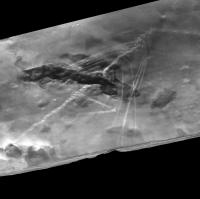
Close up CT scan, composite image of fossil gliding reptile Mecistrotrachelos apeoros. Curved foot and ribs are clearly visible The fossilized bones of a previously unknown, 220 million-year-old long-necked, gliding reptile may remain forever embedded in stone, but thanks to an industrial-size CT scanner at Penn State's Center for Quantitative Imaging, the bone structure and behavior of these small creatures are now known.
The new gliding reptile is named Mecistrotrachelos apeoros meaning "soaring, long-necked" and was found at the Solite Quarry that straddles the Virginia-North Carolina border. The researchers report in today's (June 12) issue of the Journal of Vertebrate Paleontology that the "new specimens are embedded in a hard dolomitized dark gray, silty mudstone, and only faint impressions of the bones can be seen at the surface. Repeated attempts to remove the matrix using both mechanical and chemical techniques have been unsuccessful."
"The fossils sit on sheets of stone less than a quarter inch thick," says Tim M Ryan, research associate in anthropology and member of Penn State’s Center for Quantitative Imaging. "The color of the bones is the same as the color of the surrounding matrix which makes preparation difficult."
The specimens, which were found by Nick Fraser of the Virginia Museum of Natural History, came to Penn State to be scanned on the specialized CT scanner.
"In some cases, with larger bones, we can see inside the bones," says Ryan. "However, we could not determine the exact morphology of all the appendages because smaller bones were difficult to resolve due to the size of the specimen."
The specimens were scanned at a resolution of about one tenth of a millimeter or less. The researchers could determine that the feet were curved, indicating that the reptiles probably lived in trees.
The resolution of the CT scan is largely dependent on the size of the object to be scanned. Because the researchers did not want to cut up the sheet of rock in which the fossilized glider was embedded, they gave up total resolution of all of the bones.
Because this fossil has been identified and named from CT scan, one benefit is that the bones themselves have not been destroyed or even moved. Exact positioning of the bones removes any doubts about joint connections and position. Also, both the fossil specimens and the image data from the scan are preserved and can be reviewed and reanalyzed in the future.
The scans presented to Fraser were not a perfect photograph of the two specimens, rather they were a set of thin slices that had to be processed to obtain information about the animals. Even then, no single slice contained the entire skeleton. Post-scan processing produced an amazingly clear, if somewhat flattened, image of a small reptile with a long neck and swept back wings.
Gliding behavior evolved several times in reptiles and is present in the Indonesian reptile Draco.
Source : Penn State
 Print Article
Print Article Mail to a Friend
Mail to a Friend
